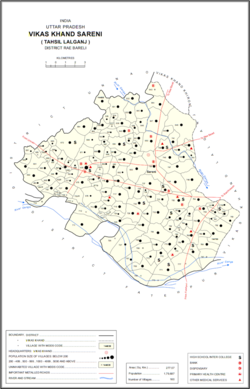|
Mangadpur
Mangadpur is a village in Sareni block of Rae Bareli district, Uttar Pradesh, India.[2] It is located 25 km from Lalganj, the tehsil headquarters.[3] As of 2011, it has a population of 403 people, in 88 households.[2] It has one primary school, no healthcare facilities, and hosts a weekly haat but not a regular market.[2] It belongs to the nyaya panchayat of Murarmau.[4] The 1951 census recorded Mangadpur as comprising 1 hamlet, with a population of 154 people (76 male and 78 female), in 31 households and 26 physical houses.[5] The area of the village was given as 172 acres.[5] No residents were literate.[5] The village was listed as belonging to the pargana of Sareni and the thana of Sareni.[5] The 1961 census recorded Mangadpur as comprising 1 hamlet, with a total population of 178 people (87 male and 91 female), in 33 households and 32 physical houses.[6] The area of the village was given as 172 acres.[6] The 1981 census recorded Mangadpur (as "Mangatpur") as having a population of 275 people, in 46 households, and having an area of 69.60 hectares.[3] The main staple foods were given as wheat and rice.[3] The 1991 census recorded Mangadpur as having a total population of 321 people (144 male and 177 female), in 61 households and 61 physical houses.[4] The area of the village was listed as 70 hectares.[4] Members of the 0-6 age group numbered 56, or 17% of the total; this group was 45% male (25) and 55% female (31).[4] Members of scheduled castes made up 82% of the village's population, while no members of scheduled tribes were recorded.[4] The literacy rate of the village was 20% (48 men and 16 women).[4] 145 people were classified as main workers (79 men and 66 women), while 0 people were classified as marginal workers; the remaining 176 residents were non-workers.[4] The breakdown of main workers by employment category was as follows: 47 cultivators (i.e. people who owned or leased their own land); 92 agricultural labourers (i.e. people who worked someone else's land in return for payment); 1 worker in livestock, forestry, fishing, hunting, plantations, orchards, etc.; 0 in mining and quarrying; 0 household industry workers; 2 workers employed in other manufacturing, processing, service, and repair roles; 0 construction workers; 0 employed in trade and commerce; 0 employed in transport, storage, and communications; and 3 in other services.[4] References
|
||||||||||||||||||||||||||||||||||

